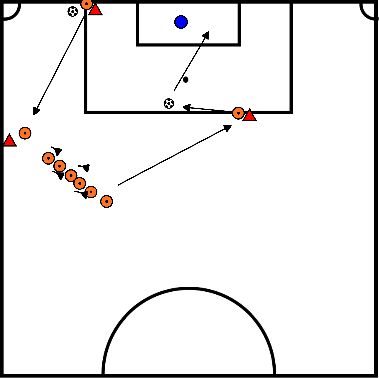Soccer drills for technique attack / offense
- All players start with a ball and dribble through the box.
- The players try to keep the ball inside the box and not collide with each other.
- The players with the ball can score points by dribbling through the small goals, not being allowed to dribble through the same small goal twice in a row.
depending on age and ability.
Length: 20-25 metres.
Width: 15-20 metres.
Goal Scoring.
- Dribble through the box (“try to keep the ball close to youâ€).
- Try to dribble where there are no other players.
- Stay active.
- All players start with a ball and dribble through the box. The defender tries to take or knock balls away from the other players.
- The defender counts how many balls he has taken or tapped away. After a certain time, the defenders are changed.
- The players with the ball can score points by dribbling through the small goals. They are not allowed to dribble through the same small goal twice.
Size: depending on age and ability.
Length: 20-25 metres.
Width: 15-20 metres.
Goal Scoring.
- Dribble through the box (“try to keep the ball close to youâ€).
- Try to dribble where there are no other players.
- Keep participating actively.
- All players start with a ball and dribble through the box.
- The players try to keep the ball inside the box and not collide with each other.
Size: depending on age and ability.
Length: 20-25 metres.
Width: 15-20 metres.
Attacking: Score goals.
- Dribble through the box (“try to keep the ball close to youâ€).
- Try to dribble where there are no other players.
- Stay active.
- Upper exercise:
- No. 2/5 has the ball.
- One of these two starts with the ball and plays in number 6.
- Number 6 bounces the ball back to number 2, number 10 in the meantime, together with number 7, make their move.
- Number two plays in number 10.
- Number 10 plays the ball deep on number 2.
- Number 2 takes the ball at the foot.
- Number 7 and 9 position themselves in front of the goal while number 2 brings the ball forward.
- Bottom exercise:
- Number 6 and 8 take turns playing the ball to number 10.
- Number 8, for example, plays to number 10.
- Number 10 bounces the ball to number 6.
- Number 6 plays the ball closely in front of number 2.
- Number 2 bounces the ball to number 7, which has entered for action as soon as number two starts running.
- Number plays the ball and the depth for number two.
- Number 7, 9, 11 make their run action towards the goal.
- Number 10 stands on the 16-metre line in front of the falling ball.
Switching positions:
- Number 6 8 and 10 switch positions. The player inserting the ball lands on the position of the player playing the ball deep for No. 2 or No. 5.
- The player playing the ball deep substitutes number 10.
- No. 10 stands behind one of the two with the least number of people.
- Numbers 7 and 2 alternate positions.
- Numbers 5 and 11 alternate positions.
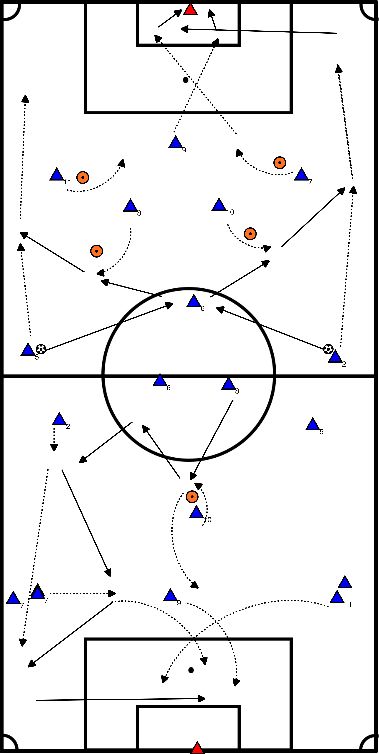
- Defence to attack in a 1-4-4-2.
- The running forms of the attack and defence are important here.
- Form two of the two where the focus is on the outfielder 7/8 creates space for the 2/5 .
- Here the six of the bb game is used to give the through ball.
- The exercise can be done without or with resistance.
- In the case of the ball owning party it is important that they do not play the ball directly on the 7/8 but first move the ball for some time between 3->4 4->5, where five gets up high as soon as the ball goes from two to three.
- When five receives the ball do not play directly to the eight but first back to the four.
- From four to three and from three to two.
- Allow the defence to pass the right running lines at the right time before they play the ball to the 7/8.
- As soon as the ball goes from the two to the seven, pay attention to the correct running lines of the seven.
- Creating space for the two is done by letting the seven get into the ball and bouncing the ball to the six.
- After bouncing from the two to the seven the two has to make a run in the deep.
- The seven bounces the ball onto the six that comes under the ball.
- The six then plays the ball deep on the two with the nine running to the first post, the eleven behind the nine and the eight around the second post in an oblique line behind the eleven and nine.
- Ten comes on the sixteen-metre line and the seven diagonally behind the two.
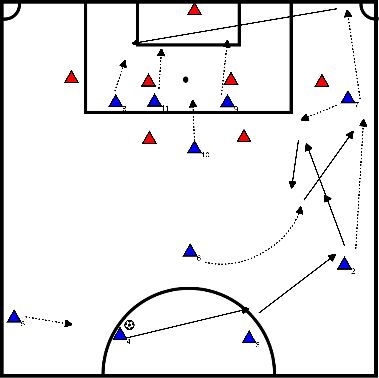
- Player passes the ball to the striker.
- Striker bounces the ball back
- A player plays the ball deep into the corner.
- The Third Player sprints in that direction and passes the ball in front.
- The first player is sprinting along and finishes on the goal.
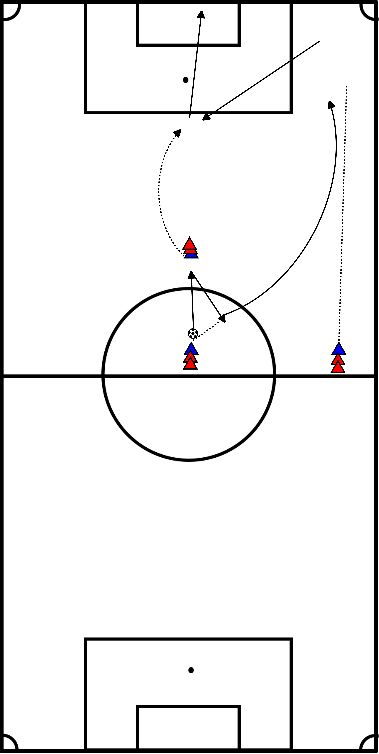
- The defenders (formation 1-2-2) try to prevent the attackers from scoring, by making the space as small as possible and conquering or blocking the ball at all costs.
- The defenders help each other by keeping the distance between them as small as possible.
- The attackers (formation 4-2) try to make the field as large as possible in order to score a goal
- After conquering the ball, the defenders can try to score in a small goal
- The attackers can score in a big goal with a goalkeeper
- When the ball goes out of the field, it is kicked back in where it went out.
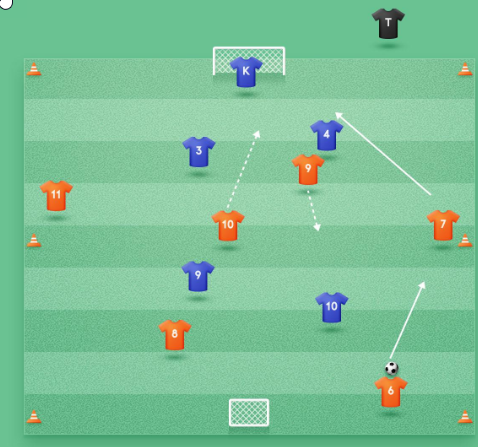
- In this exercise, an attacker is played by a midfielder while he has a defender behind him.
- The attacker must hold the ball for 5 seconds so that the midfielder can close in and receive the ball.
- The defender must try to take the ball.
- In a rectangle with a central strip, the players are divided into 2 groups facing each other.
- The exercise starts with 1 player with a jacket in the middle strip. This is the defender.
- Players must cross with the ball, the defender must take the ball and play it off the field.
- the defender shall remain only on the central strip
- If a player loses the ball, they will also put on a jacket and help the defender.
- Attackers thus keep running back and forth until there is one attacker left.
- This is the winner.
- 2 groups
- Both groups are on one side next to the goal.
- 1 player plays the ball high/low (depending on level), to player 2 who is in a square at the edge of the penalty area.
- Player 2 must check the ball in square and shoot.
- Retrieves his own ball and connects at the row next to the goal. Player of the other team was waiting behind square, now moves up.
- Must be done at high speed, otherwise it will be too static.
- The team with the most goals wins.
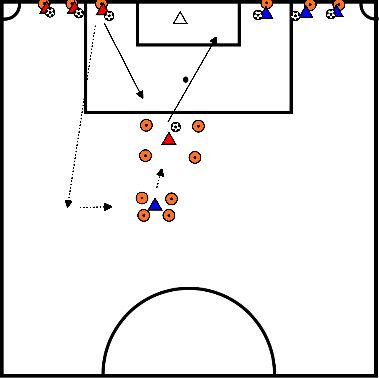
- Player 1 and Player 2 start dribbling at the same time.
- At the end they pass through pawns to the other side.
- The next player receives the ball and starts dribbling.
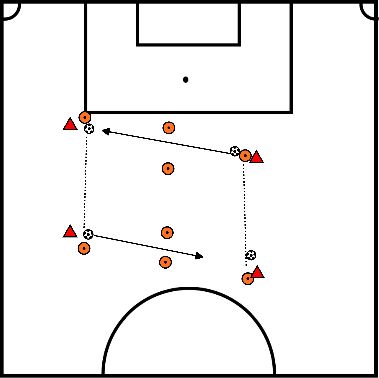
- Player 1 passes the ball to player 2.
- Player 2 dribbles along the pylons, passes at the end to player 3.
- Player 3 bounces the ball back to player 2, player 2 finishes.
- Player 3 fetches the ball,
- Runs over to stand on the spot of Player 1
- Player 1 to Player 2,
- Player 2 to Player 3.
